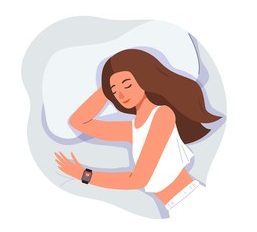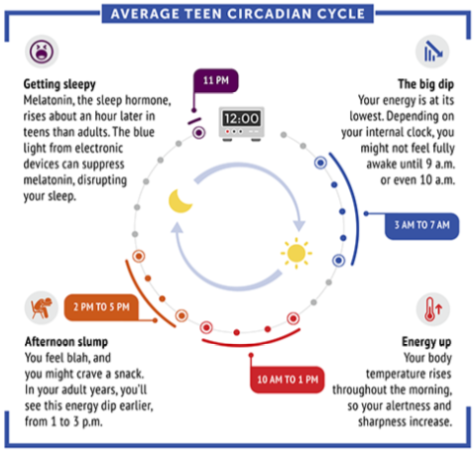More Sleep, Better Results

In fully returning to in-person learning, schools have prioritized the health and safety of students through strict rules and sanitary measures. Different start times for high schools, middle schools, and elementary schools have been newly implemented to decrease student contact and increase social distancing on buses. As a result, teens are forced to start earlier than elementary school students. While this may seem efficient, schools are overlooking a major issue regarding the health of teens: sleep.
According to the National Sleep Foundation, teens need between 8 and 10 hours of sleep each night (Suni 3). Yet, data from four national surveys conducted from 2007-2013 reported that about 69% of adolescents got a maximum of 7 hours of sleep per night (Suni 17). Sleep plays a critical role in the overall performance of students. Proposed solutions to improve student performance in schools often involve costly interventions that are difficult to implement. However, switching the start times of elementary, middle, and high school students is an easy and inexpensive solution that would allow adolescents to sleep later and, thus, provide them with more energy and motivation to learn.
Circadian rhythms, “physical, mental, and behavioral changes that follow a 24-hour cycle,” influence human sleep patterns (Circadian Rhythms 1). Furthermore, the degree of light on the outside of our eyelids affects our melatonin or “sleep hormone” secretion and feelings of alertness or fatigue (Circadian Rhythms 1). During the puberty stage, the nocturnal melatonin production of children shifts several hours later than what occurred when they were younger–or when they become adults (Carskadon et al. 1). It’s very common for teens to be unable to fall asleep until around 11:00 pm (see chart below). Therefore, the American Academy of Pediatrics suggests that adolescents sleep until at least 8:30 am (Adolescent Sleep Working Group et al. 1). Unfortunately, “93% of high schools and 83% of middle schools in the U.S. start before 8:30 a.m” (Schools Start Too Early 1). Given this discordance between natural sleep rhythms and school start times for adolescents, it’s no surprise that students lose as much as two hours of sleep per night when they start school compared to the summer (Hansen et al. 3).
Circadian rhythm cycle of a typical teenager. Credit: NIGMS.
Some may object to this idea due to the many challenges that will need to be addressed. Parents may not be able to ensure that their teen made it to school on time or at all, depending on their work schedule, and later release times can impact athletics and the ability to get homework done at a reasonable time for teens. But, the benefits outweigh those challenges. In fact, a study done by Pamela McKeever of Central Connecticut State University and her colleague Linda Clark discovered that delaying high school start times to 8:30 am improved attendance rates from 90% to 94% (Malatesta 7). Due to getting more sleep, teens have an easier time waking up and getting to school. If teens are late, they may skip school completely. Thus, delayed school times can actually offer parents relief as teens will be more motivated to get up and get to school on time.
With later start times comes later dismissal times. This raises concern regarding tight practice time constraints and teen athletes getting home even later at night. Schools and parents, however, fail to realize that sleep is way more important to the overall health and success of athletes. Sleep naturally repairs “wear-and-tear after exercise” (Pacheco 6). Athletes require more time in what is known as “slow-wave sleep” (Pacheco 6). This is when the body releases growth hormones, repairs muscles, builds bones, and manages energy stores during sleep (Pacheco 6). Teen athletes that sleep less than 8 hours each night on a regular basis are “1.7 times more likely to sustain an injury” (Pacheco 9). Sleep also leads to more wins because it increases “cognitive functions such as judgment, focus, and decision-making,” and aids in the memorization of new skills (Pacheco 7). In a study done on basketball players, increasing their amount of sleep to 10 hours per night improved “reaction time, sprint time, and shooting accuracy, as well as daytime sleepiness and overall mood” (Pacheco 8).
Others argue that later dismissal times leave less time for students to complete their homework, keeping them up later. Yet, studies show that teens actually complete more work during the day as a result of getting more sleep and having more focus and alertness. Adolescents that regularly get less than 8 to 10 hours of sleep suffer from “decreased performance, efficiency, and output, … impairments in executive function, [including] working memory, organization, time management, [and] sustained effort” and “impairments in attention and memory” (Benefits of More Sleep 12).
There are a few quick wins in education when it comes to boosting student performance at a low cost. Yet, paying attention to–and scheduling school start times in line with–human biology seems to be one of them. By giving the earliest start times to elementary school students, middle start times to middle school students, and the latest start times to high school students, adolescents will be able to get more sleep, improving overall health, motivation, and success.
Works Cited
Adolescent Sleep Working Group, et al. “School Start Times for Adolescents.” American Academy of Pediatrics, American Academy of Pediatrics, 1 Sept. 2014, https://publications.aap.org/pediatrics/article/134/3/642/74175/School-Start-Times-for-Adolescents. Accessed 17 Jan. 2022.
“Benefits of More Sleep.” Sleep For Success, https://sleepforsuccesswestport.com/benefits-of-more-sleep. Accessed 18 Jan. 2022.
Carskadon, Mary, et al. “Regulation of Adolescent Sleep: Implications for Behavior.” Annals of the New York Academy of Sciences, U.S. National Library of Medicine, https://pubmed.ncbi.nlm.nih.gov/15251897/. Accessed 17 Jan. 2022.
“Circadian Rhythms.” National Institute of General Medical Sciences, U.S. Department of Health and Human Services, https://www.nigms.nih.gov/education/fact-sheets/Pages/circadian-rhythms.aspx. Accessed 17 Jan. 2022.
Hansen, Martha, et al. “The Impact of School Daily Schedule on Adolescent Sleep.” Pediatrics, U.S. National Library of Medicine, https://pubmed.ncbi.nlm.nih.gov/15930216/. Accessed 17 Jan. 2022.
Malatesta, Elizabeth. “Let Them Sleep? Later School Start Times Improve Graduation and Attendance Rates.” NEA, https://www.nea.org/advocating-for-change/new-from-nea/let-them-sleep-later-school-start-times-improve-graduation-and. Accessed 18 Jan. 2022.
Pacheco, Danielle. “How Much Sleep Do Student Athletes Need?” Sleep Foundation, 5 Feb. 2021, https://www.sleepfoundation.org/teens-and-sleep/student-athletes-sleep-time. Accessed 18 Jan. 2022.
“Schools Start Too Early.” Centers for Disease Control and Prevention, Centers for Disease Control and Prevention, 29 May 2020, https://www.cdc.gov/sleep/features/schools-start-too-early.html. Accessed 18 Jan. 2022.
Suni, Eric. “Sleep for Teenagers.” Sleep Foundation, 22 Nov. 2021, https://www.sleepfoundation.org/teens-and-sleep. Accessed 17 Jan. 2022.

Sadie enjoys writing poetry, and spending time with the people she loves the most. Many of her poems have been featured in the Talent Unlimited magazine....

